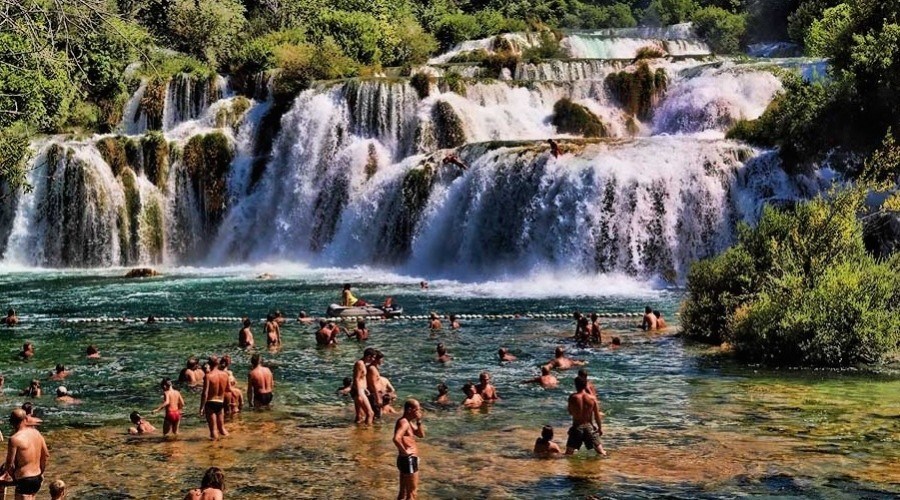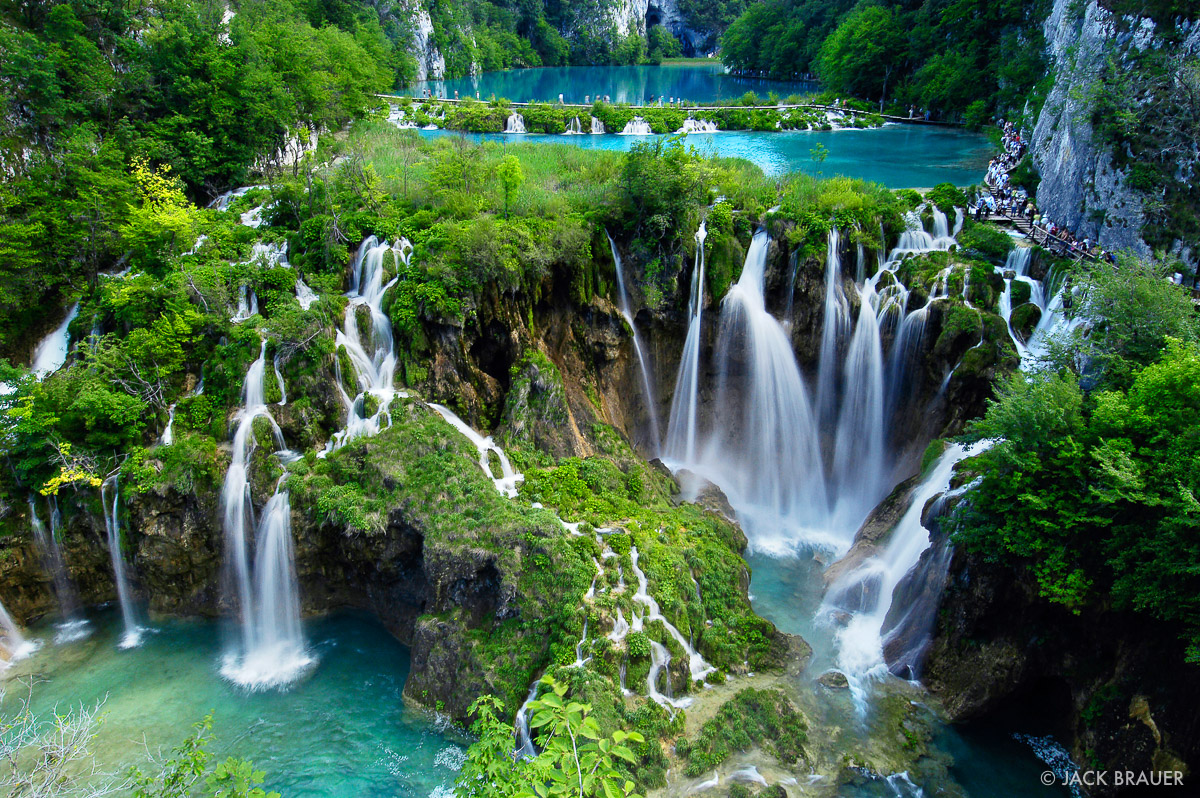National Parks in Croatia
What is it about the national parks in Croatia that make people flock to them? Whether for an active vacation or not, the beauty of nature leaves everyone in awe. It is unthinkable today to come to Croatia without visiting one of the national parks.
Croatia has 8 national parks: Brijuni, Kornati, Krka, Mljet, Plitvice lakes, Paklenica, Risnjak and Northern Velebit. The last one covers almost 8% of Croatian territory. What is interesting is whichever part of Croatia you are in, you can visit one of its national parks. If you like to organize your stay in Croatia on time, and can set aside some time to plan your choice of destinations, we recommend to put one of these Croatian pearls on your list, too. You won’t regret it.
Brijuni
Brijuni are in northwestern Istria. It is an archipelago of 14 islands and islets, the largest of which are Mali and Veliki Brijun (Small and Big Brijun). This national park is called paradise on Earth, thanks to its rich flora and fauna, well-indented coast and impressive history dating all the way to the 3rd millennium BC.
Ideal for all guests, whether we talk about family, adventure, gastro, nautical or archeological tourism. Before being established as a national park, Brijuni were Josip Broz Tito presidential home, and welcomed many famous politicians, musicians, film makers, actors and athletes. Brijuni still has that luxurious touch.
Kornati
Kornati are in Central Dalmatia, to the west of Šibenik and to the south of Zadar. The national park consists of 89 islands, islets and rocks. Vertical cliffs of the islands of Kornati, opening seaward, are a natural phenomenon and will take your breath away.
Although the mainland side of this park resembles a rocky desert, it is very rich in flora and fauna. The most beautiful description of Kornati was penned by the famous George Bernard Shaw: On the last day of Creation God desired to crown His work, and thus created the Kornati islands out of tears, stars and breath.
Kornati National Park is a paradise for sea aficionados. You can enjoy sailing, kayaking, snorkeling and swimming, undisturbed, in hidden coves. In summer, dolphins and sea turtles will bring a smile to your face. As for food, we recommend home-made pasta with seafood, fishermens fish stew with polenta or Kornati lamb. Figs are staple dessert here, either fresh, in jam or infused in cakes.
Krka
Krka is one the most-visited national parks. It is located near Šibenik. It is spread over a 109 km2 area. This national park is a natural and karst phenomenon. Aside from 7 gorgeous travertine waterfalls, Krka is home to a number of endemic endangered species, as well as over 1000 picturesque plant species.
The most visited parts of the park are Skradinski buk, Roški slap and Visovac. They are so stunning in their beauty they have become an indelible part of the postcard of Croatia. Speleology lovers are particularly drawn to this national park, as there are about 40 grottoes and pits here. This area is also well known for its archeological localities, medieval fortresses and ethnography.
Krka is an important ornithological area with over 225 bird species. Guests can enjoy all sorts of activities, such as kayaking, snorkeling, whitewater rafting, paragliding and biking in wilderness. As for pleasing your palate, do not miss Skradin risotto, peka almond bread, fig jam and, of course, Skradin gateau.
Photo Credit: Mario Fjat
Mljet
Mljet is a green island which will enchant you with colors and scents of untouched nature. Malo and Veliko jezero (Small and Great Lakes) are the parks most prominent locations, an oceanographic and geological phenomena. Small Lake is like a laguna while Great Lake is a bay formed after a karst field was sunk.
Lovers of historical heritage and archeology will be very interested in the Great Lake area, as well as in St. Mary’s islet. A vast green area attracts lovers of active life and we can safely say there are no guests who did not try a cycle or a hiking path to explore this green pearl. Adventurers use a kayak or a canoe to search for hidden coves, beaches and grottoes.
Although Mljet is well connected with Split, Dubrovnik and the nearby islands, nautical tourists are the most frequent visitors; for them, Mljet is an obligatory port. Mljet cuisine is very diverse and you can enjoy dishes prepared after old recipes. Apart from fish and shellfish, you can enjoy eel stew, smoked fish, goat milk cheese in oil, various sides of bean plants and venison, and almonds dipped in forest honey.
Plitvice
Plitvice Lakes National Park is located along the road connecting Dalmatia and the capital, Zagreb. There are 16 lakes. The magnificent beauty of the waterfalls and the exceptional value of this national park were recognized by UNESCO and put to the World Heritage List.
The lakes are called the place of magical beauty, and are our most-visited national park. Plitvice Lakes are open to visitors year round and it is hard to say which season is the most beautiful there: summer, fall, winter or spring. The incredible transformation of nature in different seasons leaves no one untouched.
There are a number of forest zones and thus many mammals and birds, as well as 72 endemic plant species and 1275 other plant species. Apart from a specific geological importance of this national park, the area has archeological significance as well, because historical evidence on life dates back all the way to ancient history.
Visitors can partake in a number of activities: a ride on an electric boat and panoramic train, long walks, rowing and, for the most active guests, skiing and biking. Traditional craft buildings, such as mills and saw-mills, are very attractive to our guests. This area is large and under great protection, so we do not recommend privately-created visits. You can stay in a hotel or private accommodation and please your palates in numerous restaurants: try Lika lamb, bakers potatoes and home-made cakes.
Photo Credit: Jack Brauer
Risnjak
Risnjak National Park is in Gorski kotar, about 15 km from Rijeka. The particularity of this park is the clash of coastal and continental climates. The park abounds in diverse flora and fauna; it is one of the few places in Europe where large animals, such as bears and wolves, can be found in their natural habitats.
There are 14 different types of forests, crushed and steep rocks and rich flora and fauna. Edelweiss holds a special place in Risnjak. It is a rare and protected flower, nowadays found only in the meadows of Risnjak. The settlements within the national park comprise mostly mountain houses, made of wood and stone. These houses are an important heritage of this region.
Risnjak is mostly visited by domestic guests, lovers of custom and tradition, and those who want an active vacation; they mostly enjoy mountain biking, sports fishing, game watching and long walks. Gourmands will especially delight in venison and wild blueberry crepes.
Paklenica
Paklenica is a part of the Velebit mountain range, well known for its diverse and attractive relief. Although there are beautiful flora and fauna here, as well as grottoes, ravines and gorges, it is the pits that attract climbing and mountaineering lovers.
The southern side of Velebit has been inhabited since ancient history, and it is interesting to look at changes of nature then and now. You can have a special experience of it at the hiking-biking trail called A short journey through the past. Paklenica captured every active guests heart, especially hearts of climbers.
The climbing tradition dates as far back as 1909, so it is no wonder Paklenica hosts international climbers gatherings. The locals say food always tastes better after spending time in fresh air and great company. Apart from classic roasted dishes, there are traditional goulash recipes as well. For dessert, try a home-made grappa or a liqueur, accompanied by freshly-made apple or cheese strudels, or home-made jam crepes.
Northern Velebit
Northern Velebit is our youngest national park. Mountains and primeval wilderness soar against a sea backdrop of gorgeous white rocks as karst and sea phenomenon. This parks untouched beauty is stunning, as well as its cultural heritage and speleology locations.
The landscape changes quite dynamically, so it is a photographers paradise. There are 30 alpine trails and each leads to beautiful viewpoints which will award you with a simultaneous view of both Lika and the sea.
Mountaineering, trekking, hiking and cycling are the most popular activities. It all depends on the guests preferences and their fitness level. Zavižan is one the most visited spots: it houses our oldest meteorology station as well as the Botanical garden. If you wish to recharge, you can stay in unique lodgings: renovated shepherd houses.
As for food, Lika potato is the most prized, so there will hardly be a meal without it. You can also try Lika lamb and a special type of cheese that creaks beneath your teeth when you eat it, called škripavac (creaking cheese). Finish your meal with grappa or sheep milk cheese or honey, apple and walnut cakes.




